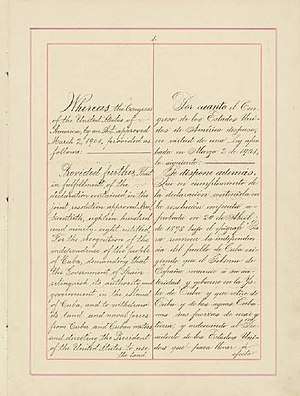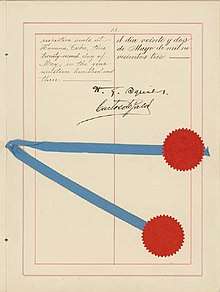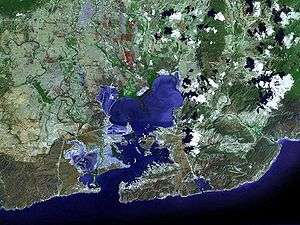Platt Amendment
On March 2, 1901, the Platt Amendment was passed as part of the 1901 Army Appropriations Bill.[1] It stipulated seven conditions for the withdrawal of United States troops remaining in Cuba at the end of the Spanish–American War, and an eighth condition that Cuba sign a treaty accepting these seven conditions. It defined the terms of Cuban–U.S. relations essentially to be an unequal one of U.S. dominance over Cuba.
.svg.png) | |
| Long title | An Act Making appropriation for the support of the Army for the fiscal year ending June thirtieth, nineteen hundred and two. |
|---|---|
| Enacted by | the 56th United States Congress |
| Citations | |
| Statutes at Large | Chapter 803, 31 Stat. 895, 897 |
| Legislative history | |
| |
On June 12, 1901, Cuba amended its constitution to contain, word for word, the seven applicable demands of the Platt Amendment.[2]
On May 22, 1903, Cuba entered into a treaty with the United States to make the same required seven pledges: the Cuban–American Treaty of Relations of 1903.[1] Two of the seven pledges were to allow the United States to intervene unilaterally in Cuban affairs, and a pledge to lease land to the United States for naval bases on the island. (The Cuban-American Treaty of Relations of 1934 replaced the 1903 Treaty of Relations, and dropped three of the seven pledges.)
The 1903 Treaty of Relations was used as justification for the Second Occupation of Cuba from 1906 to 1909. On September 29, 1906, Secretary of War (and future U.S. president) William Howard Taft initiated the Second Occupation of Cuba when he established the Provisional Government of Cuba under the terms of the treaty (Article three), declaring himself Provisional Governor of Cuba.[3][4] On October 23, 1906, President Roosevelt issued Executive Order 518, ratifying the order.[3]
On May 29, 1934, the United States and Cuba signed the 1934 Treaty of Relations that in its first article abrogates the 1903 Treaty of Relations.[5]
Background

During the Spanish–American War, the United States maintained a large military arsenal in Cuba to protect U.S. holdings and to mediate Spanish–Cuban relations.[6] In 1899, the McKinley administration settled on occupation as its response to the appearance of a revolutionary government in Cuba following the end of Spanish control.[7]
The Platt Amendment was an addition to the earlier Teller Amendment, which had previously limited US involvement in Cuba relating to its treatment after the war, particularly in preventing its annexation which had been proposed by various expansionist political entities within the US.[8][6] Senator Teller himself had a history of opposing American imperialism, criticising the American campaigns in Panama and the Philippines.[6] Yet in 1894 he had been an arch-expansionist supporting potential plans to annex Cuba, and Teller would go on to support the Platt Amendment.[6]
Some historians have questioned Teller's intentions, claiming that the real motive behind the resolution was to protect American beet sugar growers from Cuban competition.[6] On the other hand, Teller became a leading opponent of land annexation in Cuba to grow sugar in the early 1900s, as well as President Roosevelt's plans to grant tariff preferences to Cuba in 1903.[6]
The Platt Amendment originated from American mistrust in the Cuban Constituent Assembly to formulate a new relationship between Cuba and the U.S.[6] Senator Orville H. Platt, chair of the Senate Committee with Relations on Cuba, spearheaded the bill alongside General Leonard Wood, the Governor of Cuba at the time and Secretary of War Elihu Root. Tasked with balancing Cuban independence with American desires to control Cuban politicians deemed unfit for self-governance, they established The Platt Amendment to maintain public order and turn Cuba into a "self-governing colony".[7][6] The Platt Amendment was initially intended to be its own bill, but it became an amendment as the 56th Congress ended on March 4th, 1901, and there was no time for the proposal to be submitted as a separate bill.
General Leonard Wood used the financial resources of the Cuban treasury to create sanitation systems.[7] A handful of civil rights, including the right to vote, were extended to literate, adult, male Cubans with property worth $250 or more, largely resulting in exclusion of the Afro-Cuban population and women from participation.[7]
Provisions of the amendment


The Platt Amendment was introduced to Congress by Senator Orville H. Platt on February 25, 1901.[9] It passed the U.S. Senate by a vote of 43 to 20, and although it was initially rejected by the Cuban assembly, the amendment was eventually accepted by a vote of 16 to 11 with four abstentions and integrated into the 1901 Cuban Constitution.[6]
The Platt Amendment outlined the role of the United States in Cuba and the Caribbean, limiting Cuba's right to make treaties with other nations and restricting Cuba in the conduct of foreign policy and commercial relations.[10] It also established that Cuba's boundaries would not include the Isle of Pines (Isla de la Juventud) until its title could be established in a future treaty, and that Cuba must sell or lease lands to the United States necessary for coaling or the development of naval stations.[10]
It read:
Preamble: For the recognition of the independence of the people of Cuba, demanding that the Government of Spain relinquish its authority and government in the island of Cuba, and withdraw its land and naval forces from Cuba and Cuban waters, and directing the President of the United States to use the land and naval forces of the United States to carry these resolutions into effect, the President is hereby authorized to "leave the government and control of the island of Cuba to its people" so soon as a government shall have been established in said island under a constitution which, either as a part thereof or in an ordinance appended thereto, shall define the future relations of the United States with Cuba.
I. That the government of Cuba shall never enter into any treaty or other compact with any foreign power or powers which will impair or tend to impair the independence of Cuba, nor in any manner authorize or permit any foreign power or powers to obtain by colonization or for military or naval purposes or otherwise, lodgement in or control over any portion of said island.
II. That said government shall not assume or contract any public debt, to pay the interest upon which, and to make reasonable sinking fund provision for the ultimate discharge of which, the ordinary revenues of the island, after defraying the current expenses of government shall be inadequate.
III. That the government of Cuba consents that the United States may exercise the right to intervene for the preservation of Cuban independence, the maintenance of a government adequate for the protection of life, property, and individual liberty, and for discharging the obligations with respect to Cuba imposed by the treaty of Paris on the United States, now to be assumed and undertaken by the government of Cuba.
IV. That all Acts of the United States in Cuba during its military occupancy thereof are ratified and validated, and all lawful rights acquired thereunder shall be maintained and protected.
V. That the government of Cuba will execute, and as far as necessary extend, the plans already devised or other plans to be mutually agreed upon, for the sanitation of the cities of the island, to the end that a recurrence of epidemic and infectious diseases may be prevented, thereby assuring protection to the people and commerce of Cuba, as well as to the commerce of the southern ports of the United States and the people residing therein.
VI. That the Isle of Pines shall be omitted from the proposed constitutional boundaries of Cuba, the title thereto being left to future adjustment by treaty.
VII. That to enable the United States to maintain the independence of Cuba, and to protect the people thereof, as well as for its own defense, the government of Cuba will sell or lease to the United States lands necessary for coaling or naval stations at certain specified points to be agreed upon with the President of the United States.
VIII. That by way of further assurance the government of Cuba will embody the foregoing provisions in a permanent treaty with the United States.
After U.S. President Theodore Roosevelt withdrew federal troops from the island in 1902, Cuba signed the treaty the next year after which Cuba executed a lease of land to the United States for a coaling and naval station at Guantánamo Bay.[10] Originally the U.S. would have been able to build four military bases, but Cuba managed to negotiate this down to two, those being Guantanamo and Bahia Honda, which was traded in 1912 for more land at Guantanamo.[6] This was a surprise given that Secretary Root had indicated his wish for the U.S. to become the owner and enforcer of Cuba's waterfront while the Platt Amendment was being drafted.[6]
Aftermath
Following acceptance of the amendment, the United States ratified a tariff that gave Cuban sugar preference in the U.S. market and protection to select U.S. products in the Cuban market.[7] The huge American investment into sugar led to land being concentrated into the hands of the largest sugar mills, however, with estimates that 20% of all Cuban land was owned by these mills.[7] This led to further impoverishment of the rural masses. Workers on the mill were in constant fear of eviction, with cheap imported labour from other parts of the Caribbean keeping wages very low and the prices for independent cane pushed down to a minimum. In addition, the mills monopolised the railroads and ran them for private benefit. The lack of consumer purchasing power and the limited market available for manufactured goods meant that little industrialisation would occur in the decade after the 1903 Treaty of Relations. Overall, over $200 million was spent by American companies on Cuban sugar between 1903 and 1913.[7]
Tomás Estrada Palma, who had once favored outright annexation of Cuba by the United States, became president of Cuba on May 20, 1902. He was re-elected in 1905 despite accusations of fraud from his liberal opponents, but was forced to resign along with the rest of the executive when opposition against his rule turned violent.[11] The U.S. invoked the Platt Amendment to begin the Second Occupation of Cuba and install a Provisional Government.
Political instability and frequent American occupation through the early 1900s meant that legitimate constitutional rule was increasingly difficult to come about. Though Cuban citizens enjoyed an improved standard of living in this period, Article 40 of the 1901 Cuban Constitution and Article III of the Platt Amendment meant that constitutional rights could be suspended under emergency provisions.[12] Therefore, the Platt Amendment contributed to an erosion of the individual rights of the Cuban people, and it was not long before the Cuban public were calling for a replacement to the 1901 Constitution.[12]
The Platt Amendment was a major blow to hopes of social advancement for Afro-Cubans, who hoped that their participation in the Spanish-American War would mean equality with the white planters and commercial elites of Cuba. Nearly 40% of the Cuban fighting force against Spain were made up of people of colour, and Afro-Cubans had spent generations fighting for their country's independence.[13] As well as becoming disenfranchised through voting acts, Afro-Cubans were also blocked from many state institutions as they now required educational or property qualifications to be gained.[13]
Tensions between Afro-Cubans and U.S. military officials were rife, with hostile language and sometimes gunfire being exchanged between the two groups.[13] Frustrated middle class blacks would launch the Independent Party of Colour (PIC) in 1908, but this was barred by the Cuban Congress soon along with all other parties of colour, accused of inciting race war. The PIC's call for limited armed protests would eventually spark the Negro Rebellion of 1912 which killed between 3,000 and 6,000 and led to the PIC dissolving afterwards.[13] Many African-Americans also joined Afro-Cubans in solidarity, hoping that fighting for America would lead to more opportunities back home, but they too were left disappointed.[13]

Women also suffered as a result of the Platt Amendment's conditions. As with Afro-Cubans, women played important roles in the Cuban independence movement and were characterised as 'mambisas', or courageous warrior mothers symbolising the struggle for social justice.[14] However, they were also denied voting rights and female suffrage would not be obtained until 1940.[14] Any attempts by women to discuss gender equality with the Cuban government saw them labelled as nationalists or flat out ignored.[14]
Most of the Platt Amendment provisions were repealed in 1934 when the Cuban-American Treaty of Relations of 1934 between the United States and Cuba was negotiated as a part of U.S. president Franklin Roosevelt's "Good Neighbor policy" toward Latin America.[5] José Manuel Cortina and other members of the Cuban Constitutional Convention of 1940 eliminated the Platt Amendment from the new Cuban constitution.[12]
The long-term lease of Guantanamo Bay Naval Base continues. The Cuban government since 1959 has strongly denounced the treaty as a violation of Article 52 of the 1969 Vienna Convention on the Law of Treaties,[15] which declares a treaty void if procured by the threat or use of force. However, Article 4 of the Vienna Convention states that its provisions shall not be applied retroactively.
Historian Louis A. Perez Jr. has argued that the Platt Amendment resulted in the conditions it had hoped to avoid, including Cuban volatility.[16]
See also
- Pearcy v. Stranahan (1907), U.S. Supreme Court case on the status of the Isle of Pines
- Spooner Amendment (1901), pertaining to the Philippines
- Teller Amendment (1898), recognising Cuba's right to independence
References
- 1901 Platt Amendment commentary at the US Archives online
- US archives online Archived 2015-04-23 at the Wayback Machine, Date of ratification by Cuba
- Records of the Provisional Government of Cuba, National Archives and Records Administration. "Established: By a proclamation of the Secretary of War, September 29, 1906, under general authority of the Permanent Treaty of 1903 between the United States and the Republic of Cuba, with oversight responsibilities assigned to the Bureau of Insular Affairs (War Department) by EO 518, October 23, 1906. ... History: Military Government of Cuba established by Maj. Gen. John R. Brooke, December 28, 1898, as a consequence of U.S. invasion and occupation of Cuba in the Spanish–American War, in accordance with Presidential order published in General Order 184, Headquarters of the Army, December 13, 1898. Spanish colonial administration formally terminated, January 1, 1899. Republic of Cuba established by transfer of sovereignty, May 20, 1902. Domestic unrest in Cuba led to the proclamation of September 29, 1906, which designated Secretary of War William H. Taft as Provisional Governor of Cuba. Taft succeeded as Provisional Governor by Charles E. Magoon, October 13, 1906. EO 518, October 23, 1906, ordered Governor Magoon to report to the Secretary of War through the Bureau of Insular Affairs. Military government terminated January 28, 1909."
- "William H. Taft in Cuba". www.historyofcuba.com. Retrieved 2020-01-24.
- Sklar, Barry, Hagen, Virginia (1972). "Treaty between the United States and Cuba May 29th 1934". Yale Law School- The Avalon Project.
- Schoultz, Lars, Beneath the United States: A History of U.S. Policy Towards Latin America (Cambridge: Harvard University Press, 1998), pp.139-151.
- Keen, Benjamin and Haynes, Keith, A History of Latin America: Volume 2 Independence to the Present (Boston: Houghton Mifflen Co., 2004), pp.379-380.
- "Teller and Platt Amendments". Hispanic Division Library of Congress. 2011.
- LaRosa, Michael, O. Mora, Frank (2015). Neighborly Adversaries 3rd edition. Boulder: Rowman & Littlefield. p. 105.
- "Platt Amendment 1903". Our Documents. 1903. Retrieved 24 January 2020.
- Thomas, Hugh (1971). Cuba: The Pursuit of Freedom. New York: Harper and Hugh. p. 472.
- Wachs, Jonathan (1996). "Reviving the 1940 Cuban Constitution: Arguments for Social and Economic Rights in a Post-Castro Government". American University International Law Review. 10.1: 525–569.
- Brock, Lisa (1994). "Back to the Future: African-Americans and Cuba in the Time(s) of Race". Contributions in Black Studies. 12.3: 9–32.
- Davies, Catherine (1996). "National Feminism in Cuba: The Elaboration of a Counter-Discourse 1900-1935". The Modern Language Review. 91.1: 107–123.
- Nations, United (2020). "Vienna Convention on the Law of Treaties". United Nations Treaty Collection.
- Perez, Louis (1986). Cuba Under the Platt Amendment, 1902-1934. Pittsburgh: University of Pittsburgh Press.
